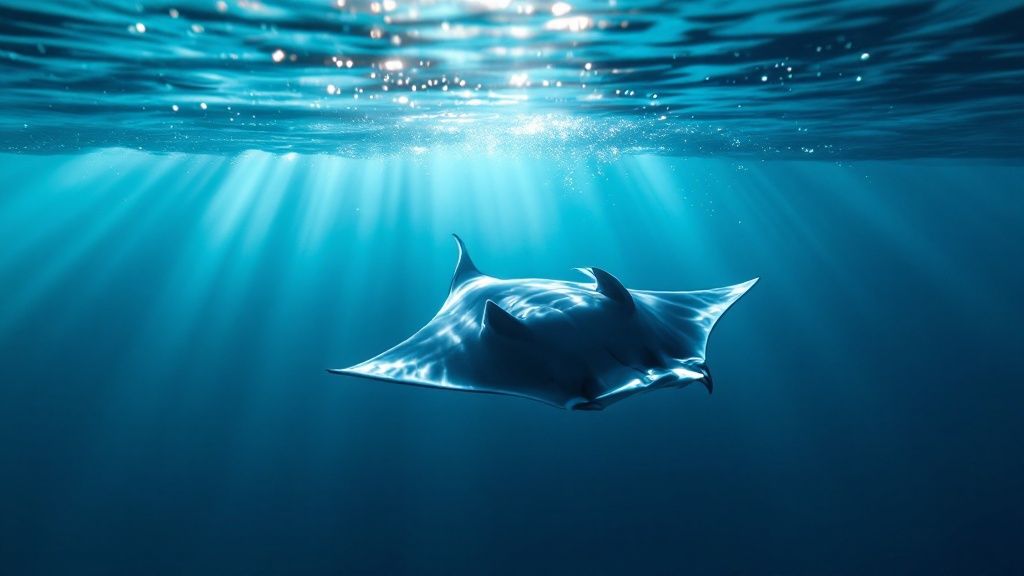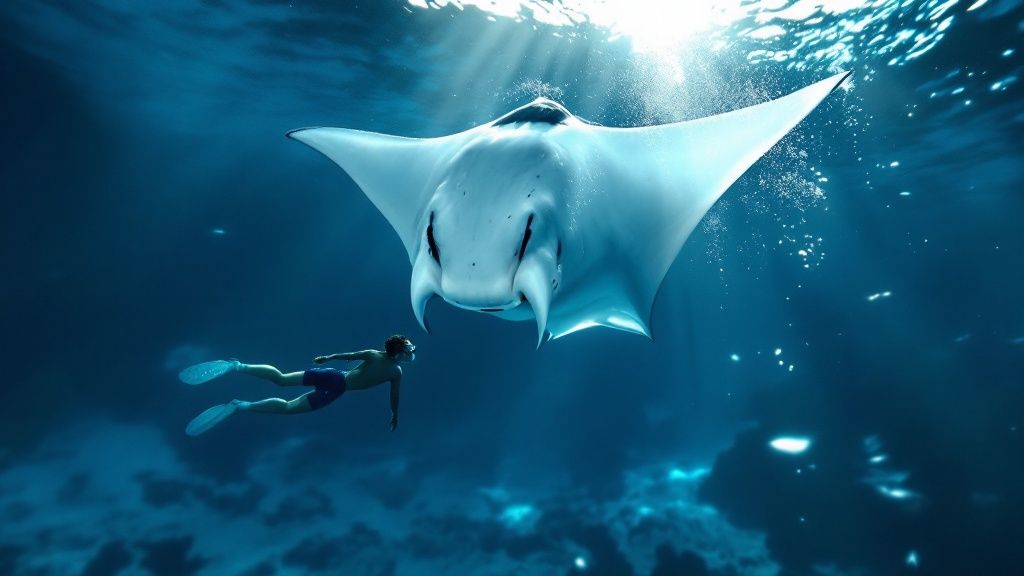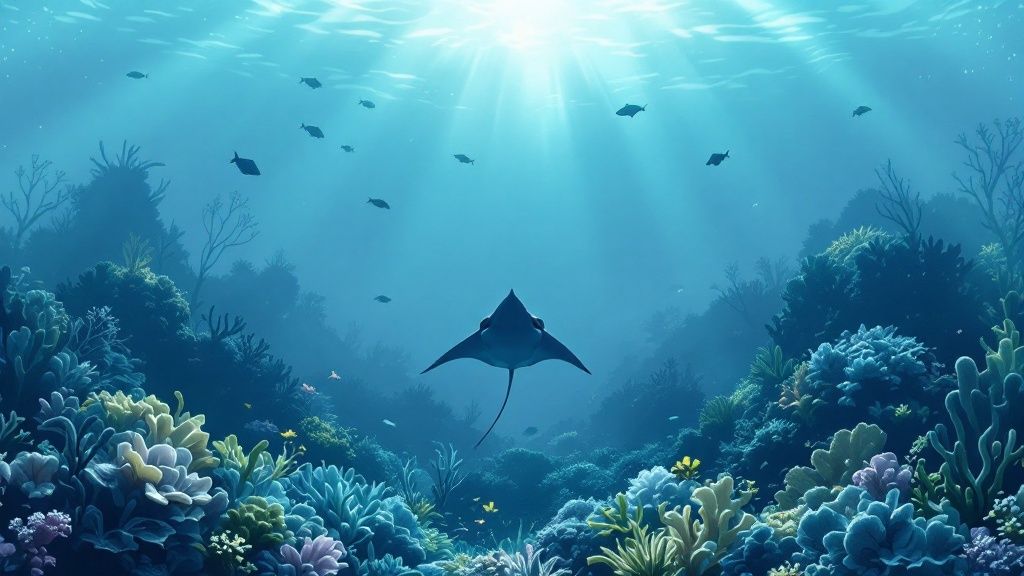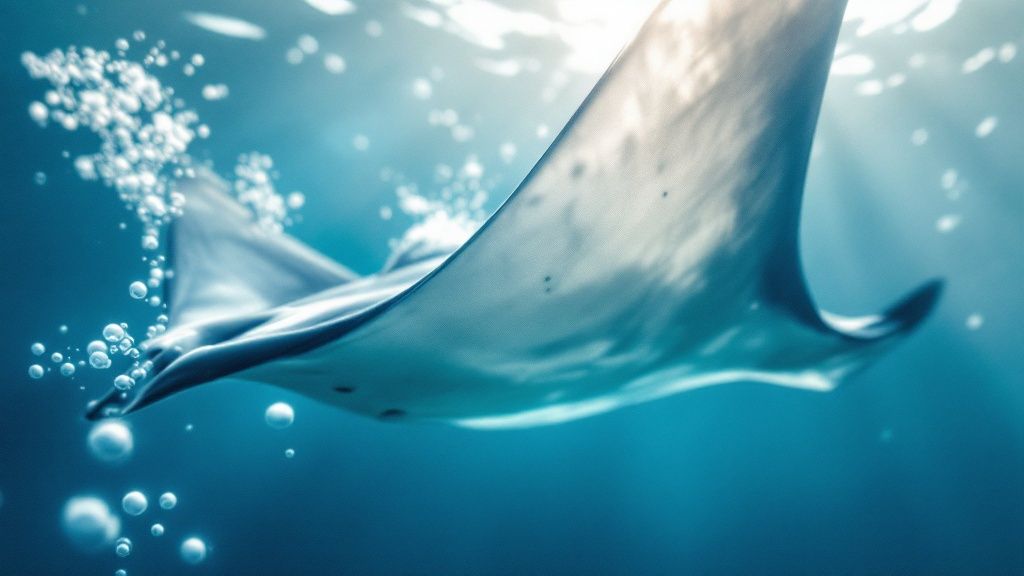Manta Ray Swim Kona Hawaii: Your Ultimate Encounter Guide
- Byron
- Apr 6
- 12 min read
Why Kona's Waters Create Perfect Manta Ray Encounters

The Kona Coast of Hawaii isn't just another pretty vacation spot. It's world-renowned for incredible manta ray encounters. What sets this area apart? It's a special blend of geology and ecology creating a haven for these gentle giants. Kona's volcanic formations shape the underwater landscape, creating nutrient-rich upwellings that attract plankton, the main food source for manta rays. The sloping seabed off the coast is particularly good for these upwellings.
The Plankton Buffet: Kona's Underwater Dining Room
This abundance of plankton makes Kona's waters a natural feeding ground for manta rays. Despite their size, these creatures are filter feeders, consuming massive amounts of microscopic organisms. Kona's nutrient-rich currents provide a constant buffet, attracting mantas in predictable patterns. This reliable food source is why Kona boasts year-round manta ray sightings. The warm water also encourages plankton growth, making the area even more attractive to mantas.
Night Feeding Behaviors and Predictable Sightings
Manta rays are mostly nocturnal feeders. This, along with Kona's clear water, has led to special night snorkeling and diving tours. Operators use lights to attract plankton, bringing the mantas closer to the surface. The best way to experience these creatures at night is a night snorkel tour. You can read more about the Manta Ray Night Snorkel in Hawaii. It's a truly mesmerizing experience to witness their feeding dances in the illuminated water.
A Hotspot Built on Research and Conservation
Manta ray sightings around Kona have been thoroughly documented. Between 2009 and 2014, Manta Ray Advocates tracked individual manta rays, recording their location and condition. This research provided key insights into manta ray travel patterns, helping to predict periods of increased sightings. These efforts, combined with Kona's unique ecosystem, lead to consistent and predictable viewing opportunities. The research also showed stability in manta ray sightings, deepening our understanding of their behavior and preferred habitats. Learn more about manta ray statistics. This focus on understanding manta ray behavior is vital for sustainable tourism and creating unforgettable encounters. This ongoing research and dedication to conservation ensure Kona remains a top spot for manta ray swim Kona Hawaii experiences.
Kona's Premier Manta Ray Viewing Locations Revealed

Kona, Hawaii, is a haven for manta ray enthusiasts, offering several unique viewing locations. Two of the most popular spots are Garden Eel Cove (Manta Heaven) and Keauhou Bay (Manta Village). Each site offers a distinct experience, making it important to understand their nuances before choosing your adventure.
Garden Eel Cove (Manta Heaven)
Garden Eel Cove, aptly nicknamed Manta Heaven, is a favorite among visitors. Its calm, shallow waters make it perfect for beginners and those seeking a relaxed experience. The seabed's unique topography encourages plankton upwellings, creating a rich feeding ground for manta rays. Local captains often highlight the underwater formations that concentrate these plankton blooms, increasing your chances of a memorable encounter.
Keauhou Bay (Manta Village)
Keauhou Bay, known as Manta Village, provides a different, yet equally captivating, experience. While accessible to snorkelers, its deeper areas also attract experienced divers. The bay is known for its lively atmosphere, often with multiple manta rays feeding simultaneously, creating a truly spectacular sight.
The bay's proximity to shore offers practical benefits as well. Shorter boat rides mean more time in the water with the mantas. Many tour operators, including Kona Honu Divers and Captain Cook Snorkeling Tours, frequent this location.
Choosing the Right Location for Your Needs
Selecting the perfect spot depends on your experience level and desired encounter. Do you prefer a tranquil experience in calmer waters or a more dynamic multi-manta spectacle? Kona Snorkel Trips and Manta Ray Night Snorkel Hawaii often operate in both locations, offering some flexibility. Consider the water conditions and the type of experience you seek. You might also be interested in more information on manta ray encounters.
To help you decide, we've compiled a comparison of the top manta ray viewing sites in Kona:
The following table provides a detailed comparison of the main manta ray viewing locations along the Kona coast, highlighting their unique characteristics and suitability for different experience levels.
Location | Also Known As | Average Depth | Best For | Success Rate | Special Features |
|---|---|---|---|---|---|
Garden Eel Cove | Manta Heaven | 15-25ft | Beginners, Calm Water | High | Consistent plankton upwellings, shallow depths |
Keauhou Bay | Manta Village | 25-40ft | Divers, Multiple Mantas | High | Deeper areas, close to shore, frequent manta ray activity |
Makako Bay | - | 30-50ft | Experienced snorkelers/divers | Moderate | Often less crowded, diverse marine life |
Honokohau Harbor | - | 20-30ft | Families, Beginners | Moderate | Calm harbor waters, occasional manta ray sightings |
As you can see, each location offers unique advantages. Choosing the right spot can significantly enhance your manta ray adventure. Understanding these nuances truly adds to the magic of experiencing these magnificent creatures in their natural habitat.
Selecting Your Perfect Manta Ray Tour Experience
Choosing the right manta ray tour in Kona, Hawaii, can transform a simple memory into a truly magical experience. With a variety of tour operators available, understanding the key differences is crucial. Factors like boat size, guide expertise, and equipment quality play a significant role in shaping your encounter. This guide will help you navigate the options and choose the perfect adventure.
Evaluating Kona's Leading Manta Ray Tour Providers
Several reputable companies offer manta ray swims in Kona. Here's a comparison of four popular choices: Kona Honu Divers, Manta Ray Night Snorkel Hawaii, Kona Snorkel Trips, and Captain Cook Snorkeling Tours. Each company offers a unique approach, from varying boat sizes and group limits to their emphasis on sustainable practices.
Kona Honu Divers: Known for small groups, personalized service, and a strong focus on conservation.
Manta Ray Night Snorkel Hawaii: Offers both sunset and nighttime tours, allowing you to experience manta rays in different lighting conditions.
Kona Snorkel Trips: Caters to all experience levels, with options for both beginners and seasoned snorkelers.
Captain Cook Snorkeling Tours: A well-established company recognized for its knowledgeable guides and high-quality gear.
Beyond the Marketing: Identifying True Eco-Conscious Operators
Looking beyond marketing slogans is key to understanding a tour operator's genuine commitment to eco-conscious practices. True sustainability goes deeper than simply advertising “eco-friendly” tours. For example, some operators actively participate in manta ray research and conservation projects. This vital data collection contributes to protecting these magnificent creatures. Furthermore, the economic impact of manta ray tourism plays a crucial role in conservation efforts. Night dives focused on manta rays generate over $2.5 million annually for the Kona community. This economic incentive encourages the preservation of Hawaii's precious marine biodiversity. Learn more about manta ray conservation and its economic impact here. You might be interested in: Manta Ray Night Snorkel Hawaii's site structure.
Premium vs. Budget: Understanding the Real Value Differences
While budget-friendly tours are available, investing in a premium manta ray swim often provides a richer experience. Smaller group sizes typically mean more personalized attention from guides and a less crowded in-water encounter. Premium tours may also offer higher-quality equipment, such as wetsuits designed for optimal comfort and clear underwater visibility. Ultimately, the most important factor isn't the price, but the operator's dedication to responsible tourism and creating unforgettable, meaningful interactions with the manta rays.
Making the Right Choice for Your Manta Ray Adventure
The perfect manta ray tour depends on your individual preferences and needs. Do you prefer a small, intimate group, or a more lively atmosphere? Are you comfortable swimming in open water at night, or would you prefer a shorter, less intense experience? By carefully weighing these factors and researching the available options, you can ensure an exceptional manta ray encounter in Kona, Hawaii.
The Complete Manta Ray Swim Journey: From Boat to Ocean

A manta ray swim in Kona, Hawaii, is an unforgettable adventure. It's a carefully planned experience, designed to maximize your enjoyment while respecting these gentle giants. From the initial dockside check-in to the thrilling in-water encounters, every detail contributes to a truly remarkable journey.
Preparing For The Journey: Check-In and Briefing
Your adventure begins with check-in, typically near the harbor. You'll meet your guides and fellow snorkelers, get fitted for your wetsuit or snorkeling gear, and have the chance to ask any questions. Most operators, like Kona Honu Divers, provide wetsuits for warmth in the cooler evening waters.
A pre-trip briefing covers essential safety procedures, responsible manta ray interaction guidelines, and a preview of what to expect during your time in the water. This is an excellent opportunity to address any concerns and ensure you're fully prepared for the experience.
From Dock to Destination: The Boat Ride
The short boat ride to the manta viewing site offers scenic views of Kona's stunning coastline. It's a chance to relax, soak in the beauty of the island, and build anticipation for the manta encounters to come.
Operators such as Manta Ray Night Snorkel Hawaii often choose locations like Keauhou Bay, known for its high manta ray activity. During the ride, your guides will share fascinating insights about manta rays, their behavior, and the unique Kona ecosystem.
The "Campfire" Awaits: Entering the Water and the Manta Ballet
The real magic unfolds at the viewing site. Large, specialized lights are deployed to attract plankton, creating a mesmerizing "campfire" effect. This illuminated area becomes a stage for the mantas' graceful feeding ballet.
As the plankton gathers, the mantas arrive, often performing acrobatic loops and barrel rolls as they feast. You'll enter the water and hold onto a floating platform, equipped with lights and handholds, providing optimal viewing. Companies like Kona Snorkel Trips use this technique to ensure a comfortable and safe experience. Remaining calm and avoiding sudden movements are key to respecting the mantas and fully appreciating their natural behavior.
The following table outlines a typical manta ray snorkeling tour timeline:
Manta Ray Swim Experience Timeline
Time | Activity | Tips | What to Watch For |
|---|---|---|---|
6:00 PM | Check-in | Arrive early to complete paperwork | Meet your guides and group |
6:30 PM | Briefing | Listen attentively to safety guidelines | Learn about manta rays |
7:00 PM | Boat Departure | Enjoy the scenic ride | Kona's beautiful coastline |
7:30 PM | Arrive at Manta Viewing Site | Get ready to enter the water | Watch for the "campfire" lights |
7:45 PM | In-Water Manta Viewing | Remain calm and observe | Manta rays feeding and swimming |
8:15 PM | Return to Boat | Share your experience with others | Discuss the amazing encounter |
8:45 PM | Arrive back at the dock | Reflect on the magical experience | Plan your next Kona adventure! |
This timeline gives a general overview. Specific times and activities can vary depending on the tour operator and conditions.
Post-Swim Reflections: Return and Memories
After 20-30 minutes in the water, you'll return to the boat, filled with excitement. The journey back provides a perfect opportunity to share stories, compare photos, and reflect on the magic of your close encounters.
Many operators, including Captain Cook Snorkeling Tours, emphasize responsible tourism. This means minimizing environmental impact and respecting these incredible creatures. The manta ray swim isn’t just a tour; it’s a chance to connect with nature and contribute to conservation efforts, creating lasting memories.
The Fascinating Science of Manta Ray Identification
Beyond the thrill of a manta ray swim in Kona, Hawaii, lies the captivating world of citizen science. Each manta ray has a unique belly pattern, similar to a human fingerprint. This natural identification system allows researchers to track individual mantas, leading to a deeper understanding of these amazing creatures.
How Identification Works: Nature's Fingerprint
The distinctive spot patterns on the mantas' ventral (belly) sides are key to identifying individuals. Researchers and citizen scientists use underwater photography to document these patterns. Organizations gather photos from manta ray tours and other encounters. This collaborative effort builds a comprehensive database of manta ray sightings around Kona.
Building a Database: Decades of Data
By carefully cataloging these spot patterns, researchers have created a vast library of identified manta rays. This database unveils insights into manta ray behavior, migrations, and social structures. It also allows scientists to estimate population size and monitor long-term trends, essential information for effective conservation strategies.
Manta rays in Hawaii are identified through their unique ventral spot patterns. This allows researchers to track individuals, providing information about their behavior and home ranges. The database maintained by organizations like mantarays.info contains thousands of reported encounters and sightings. Over 14 years, more than 330 individual manta rays have been identified. More detailed statistics can be found here. Citizen science plays a vital role in this research, helping to study and understand the Kona manta ray population.
You Can Contribute: Citizen Science in Action
You might find these Manta Ray Night Snorkel Hawaii pages helpful. Even snapshots from your own manta ray swim in Kona can contribute to this ongoing research. Submitting your photos to research organizations could help identify a new manta ray or add valuable tracking data for known individuals. Popular Kona tour operators like Manta Ray Night Snorkel Hawaii, Kona Snorkel Trips, and Captain Cook Snorkeling Tours often encourage guests to share their photos. This ongoing identification system is vital for understanding manta ray behavior, migration patterns, and ultimately, developing effective conservation efforts.
Conservation Through Identification
This detailed tracking allows conservationists to monitor population trends and the overall health of manta ray communities. This knowledge is crucial for protecting these vulnerable animals and ensuring their long-term survival. The identification system improves our understanding of manta ray behavior, providing valuable data for conservation work. This information helps researchers assess the impact of environmental changes and human activities on manta ray populations, contributing to more informed conservation strategies.
Ethical Encounters: Supporting Manta Ray Conservation

Swimming with manta rays in Kona, Hawaii is a truly special experience. These graceful creatures are vulnerable, making responsible tourism absolutely essential for their continued well-being. This means understanding the challenges they face and following ethical guidelines during your manta ray swim adventure in Kona.
Hawaii's Commitment to Manta Ray Protection
Hawaii has taken a leading role in manta ray conservation. Since 2009, the state has banned the intentional capture or killing of manta rays. This important legislation recognizes the ecological and economic value of these animals. This creates a sanctuary for the reef manta rays often seen off the Kona Coast.
However, manta rays face different challenges worldwide. The giant manta ray is classified as endangered due to threats like overfishing. While the reef manta ray population is generally more stable in protected areas like Hawaii, they still require ongoing conservation efforts. More detailed information on manta ray populations can be found here.
Responsible Practices for Sustainable Encounters
Responsible interactions during manta ray swims are critical. Tour operators play a vital role in educating visitors about best practices. Maintaining a respectful distance is one key aspect. Getting too close can disrupt the mantas’ natural feeding patterns and potentially harm their sensitive skin.
Flash photography is also highly discouraged. These sudden bursts of light can disorient and frighten the mantas. This can disrupt their feeding and cause unnecessary stress.
Maintain a safe distance: Give the mantas plenty of room to feed and move freely. Think of it as observing a beautiful ballet from afar.
Avoid touching mantas: Their skin is covered in a protective mucus layer easily damaged by human contact, increasing their susceptibility to disease.
No flash photography: The intense light can be detrimental and disorienting to the mantas.
Collaborative Conservation: Tour Operators and Researchers
Many tour operators in Kona actively participate in manta ray research and conservation. They collaborate with scientists, gathering valuable data and implementing sustainable tour practices. This collaborative approach works to strike a balance between tourism and conservation, ensuring the protection of manta rays for generations to come.
Kona Honu Divers, Manta Ray Night Snorkel Hawaii, Kona Snorkel Trips, and Captain Cook Snorkeling Tours are just a few examples of operators committed to these principles. You can learn more by checking out Manta Ray Night Snorkel Hawaii's blog categories. Choosing responsible operators and following ethical guidelines allows you to actively contribute to the well-being of these magnificent creatures.
Insider Secrets for an Unforgettable Manta Ray Swim
Want to elevate your manta ray swim in Kona, Hawaii from good to truly exceptional? These insider tips, gathered from experienced guides and marine experts, will help you make the most of your encounter with these gentle giants.
Positioning Yourself for the Best Views
Where you are in the water greatly affects what you'll see. Most tours use a stationary light board to draw in plankton, which then attracts the manta rays. Holding onto the board puts you right in the prime viewing spot.
But just holding on isn't enough. Consider the current and try to position yourself so the mantas swim toward you. This gives you a head-on perspective of their impressive wingspan. Be aware of your surroundings and adjust your position as needed.
Overcoming Seasickness and Night Swimming Anxiety
Night swims can be a little daunting, but there are ways to make it more comfortable. If it's your first night snorkel, preparing beforehand can ease anxiety. Try practicing with your gear in a pool or calm water during the day to build confidence.
If you're prone to seasickness, motion sickness medication or acupressure wristbands can be very helpful. These simple steps can significantly improve your comfort level, allowing you to fully enjoy the experience.
Choosing the Ideal Time for Your Excursion
When you go on your manta ray swim in Kona is important. Moonlight affects how well you can see the plankton, which influences the manta rays' feeding habits. Brighter moon phases typically mean better visibility.
However, even with a bright moon, cloudy nights can reduce visibility. Also, think about seasonal changes and weather. Kona offers sightings year-round. However, the calmer seas during the summer months often offer ideal viewing conditions. Learn more on the Manta Ray Night Snorkel Hawaii blog.
Photography Tips: Capturing the Magic Responsibly
Getting great photos is a priority, but responsible photography is essential. Don't use flash photography. The sudden burst of light can frighten and disorient the manta rays.
Instead, use natural light or a red-light setting. This is less disruptive to their sensitive vision. You’ll still capture amazing images without harming the mantas. Keeping a respectful distance is also vital so you don't disturb them while they’re feeding.
Reading Manta Ray Behavior
Understanding manta ray behavior can enhance your experience. For example, mantas often perform barrel rolls or backflips while feeding – a truly amazing sight.
Pay attention to changes in their swimming patterns. This might indicate an approaching manta or a shift in the plankton concentration. These subtle cues offer fascinating insights into manta ray behavior. By understanding these behaviors, you'll better appreciate their underwater ballet.
Ready for an unforgettable manta ray adventure? Book your Manta Ray Night Snorkel Kona Hawaii Tour now!
Comments